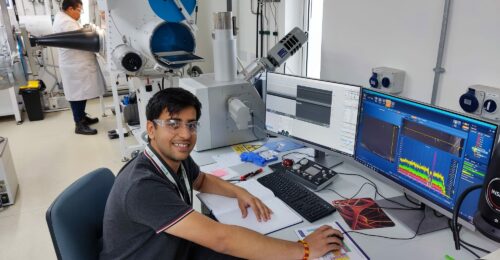Location, location – why development sites are important for SMRs
When talking to people about making the FLEX reactor a reality, many of the questions they ask are related to our technology, and it’s good to tell them that MoltexFLEX is well on the way to solving – or indeed has largely already solved – a great deal of the science and engineering challenges involved in creating our unique molten salt reactor. It’s less common for people to ask where we’re planning to build our prototype, yet in many ways, this question is just as interesting and important – and one that is at the forefront of our mind and the minds of our investors as we eagerly look forward to the Government’s upcoming publications this Autumn:
- A consultation on alternative routes to market for new nuclear projects
- A consultation on nuclear power plant siting considerations
- A nuclear roadmap
A single FLEX reactor unit (excluding peripherals such as the GridReserve® thermal energy storage system, steam generators, turbines, control facilities, and so on) is tiny in comparison with large-scale nuclear plants. But even though each FLEX reactor occupies an area only a little larger than a couple of tennis courts, there are a number of important steps to complete before we start to build our first-of-a-kind (FOAK) reactor. These steps relate to the way nuclear sites are regulated and given consent in the UK.
According to UK laws and policies, it’s possible to build a nuclear plant on a greenfield site. But just because it’s possible doesn’t mean it is the best option. Before putting spades in the ground, a thorough assessment of a site’s suitability for a nuclear plant is essential. This process involves evaluating numerous conditions and takes time to accomplish. In the future, we expect nuclear technologies to be developed on more sites and in more communities, making it easier to create new nuclear sites close to where energy is needed. But to secure the necessary permissions and consents for rapid deployment of our FOAK reactor, it probably makes sense to build at a site that’s previously been licensed for nuclear development, making the best use of existing site information, infrastructure and community engagement.
Planning permission is one consideration. MoltexFLEX has two options here: we could apply for a Development Consent Order under the 2008 Planning Act, or we could apply for planning permission under the Town and Country Planning Act since the FLEX reactor’s output is under 50MWe.
Aside from permissions and consents, securing a ‘nuclear site licence’, even at an existing site, is an important step, and involves the licence-holder, the site, and the infrastructure developed on it. Any company or organization wishing to gain such a licence, which gives permission to own and operate a nuclear plant at a specific site, has to demonstrate that it has the capability of doing so – in other words, that it has the relevant employees, organizational structures, and so on. This would take significant time and resources for MoltexFLEX to develop on our own. As with so much else in the nuclear sector, partnering with an existing organization that already has these capabilities in place could offer a more streamlined solution. For example, we could consider building on a current or previously licensed site, partnering with an existing operator from the UK or abroad, or even seeing if FLEX reactor operations could be classed as a variation of activities under an existing licence. These are all options we are investigating.
The Office for Nuclear Regulation would still need to formally assess the FLEX design, either directly through the site licence application, through a variation to an existing licence, or through a Generic Design Assessment followed by or in parallel to a site licence. The assessment process would be essentially the same, but the subsequent steps to get to construction would differ.
MoltexFLEX is working to find the right solution to the above questions to ensure we can deliver FLEX units to market within the shortest possible timeframe. Of course, we’re considering this against the backdrop of the UK’s hugely exciting programme to deliver 24GWe of new nuclear build by 2050. Although MoltexFLEX is not being taken forward in the current round of Great British Nuclear SMR procurement, this materially changes very little for the company. We’ve always been confident in our ability to bring the FLEX reactor to market by working closely with government to understand the structural arrangements for advanced nuclear technology development and in parallel securing the private investment to fund the technology development and the FOAK project, so we’ll continue to pursue this route.
The good news is that a number of sites are potentially available in the UK, especially where existing nuclear power plants have (sadly) reached the end of their working life and are either being decommissioned or preparing to do so. For example, sites such as Dungeness in Kent, Wylfa on Anglesey and several others have all been homes to nuclear plants over the past 50 years or more, and the existing infrastructure at these sites would make them ideal places to build the first FLEX reactor.
A further bonus for the community that hosts the site of the first FLEX reactor will be the opportunity to become a key support and knowledge hub for the global roll-out of the technology. It will provide an opportunity to leverage the existing nuclear skills in the area and create long-term, highly skilled jobs.
As a British company, we of course want to develop the FLEX reactor in the UK. Another advantage of developing nuclear tech in Britain is that its nuclear regulations and standards are admired around the world. To quote the UK Government: “In the UK, we have a well-respected regulatory system which reflects international best practice, and an industry which places an extremely high value on safety, achieving world-leading health and safety standards every time it is examined.” This means that if we get the go-ahead in the UK, it will be easier for other countries to license FLEX reactors, making mass global deployment of this transformational clean energy technology much faster.
Even if we don’t secure a UK site for our first reactor, we still have plenty of options available. Many countries worldwide are interested in developing small modular nuclear technology, and we have so far had some very promising initial conversations with nations who see the potential of MoltexFLEX technology.
Just as ‘a journey of a thousand miles begins with one step’, the many FLEX reactors that will be built will start with just one – and where this will be sited is perhaps the most important step of all.





